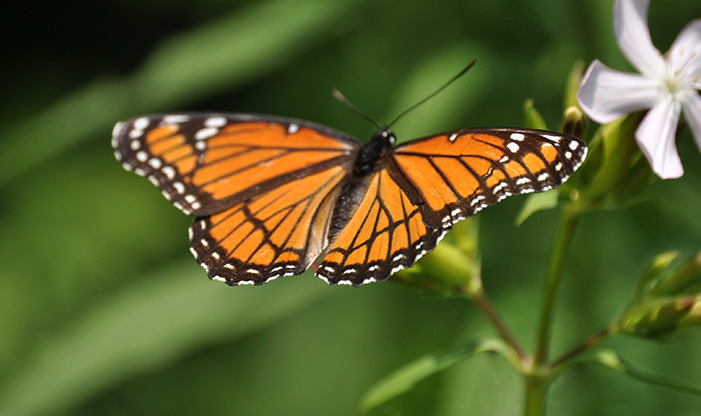There are two species of butterflies you may find at the Center in summer that are difficult to tell apart. The monarch butterfly and the viceroy butterfly look very similar in the field yet are very different species. Luckily, they have characteristics that can help identify them throughout their lifecycle. Here are some guidelines that will help you distinguish between these butterflies.
These species’ appearance begins to differ during development, beginning with the egg. The monarch’s tiny, light green egg grows and hatches on the milkweed plant. This plant becomes the caterpillar’s sole food source as it develops. The monarch caterpillar, a greenish-yellow and white striped insect, eats only milkweed leaves. Theses leaves contain a milky-colored sap which makes it unpalatable to predators. It’s very easy to spot as it chews through milkweed leaves and grows. The viceroy egg, on the other hand, is small and green with hairy bristles, and grows and hatches on the willow tree. The hatched caterpillar is smaller than the monarch caterpillar, and is brown and green in color, scattered with white, and looks like bird droppings, making it inconspicuous to predators.
Monarch and Viceroy Chrysalises
The monarch caterpillar forms a chrysalis during its metamorphosis. The caterpillar will go through five stages or instars. The chrysalis is a light green enclosure formed when the caterpillar sheds it’s fifth and final time. The chrysalis will turn black from the color of the wings inside when the monarch is about to emerge. The monarch leaves the chrysalis when it has fully transformed into a butterfly. The viceroy chrysalis is shiny brown and white, with a paler abdomen and a large knob-like structure on its thorax.
When they emerge as adults, monarch butterflies are burnt orange, with black veins appearing on the upper and undersides of their wings and distinct white spots on their edges, with a wingspan of about 3.5-4 inches. Viceroys are almost indistinguishable in color and have similar wing markings. If you see these two species beside one another, it’s hard to differentiate them, but there are subtle differences that a closer assessment will reveal. The adult viceroy has a black horizontal stripe across the hindwing, which isn’t present on the monarch. You also will notice that the viceroy is smaller by about an inch, with a wingspan of about 2.6-3 inches.
Flight and Migration
Monarchs fly in a lilting flap and glide pattern, while the viceroy is faster and more erratic. Also, viceroy don’t migrate like the monarch. They overwinter as a first or second instar larvae, rolled up in a leaf on their host, emerging in spring to become a butterfly. Monarchs first arrive in the southern U.S. during spring, after overwintering in Mexico. This dormant stage is called “diapause.” Imagine: these are the same butterflies that migrated south in the fall! This super-generation can live 7 – 9 months. The ones we see in summer may be the second or third generation, each living only a few weeks. There are four generations total in an annual cycle. The fourth generation will fly to Mexico from Wisconsin around the beginning of September and the cycle begins again.
Both insects are unpalatable to predators. When two or more different species have this type of defense and they look so much alike, they are called Müllerian mimics. This is a type of mimicry in which two or more noxious animals have similar appearances, increasing their shared protection. The monarch butterfly achieves this by ingesting toxic cardiac glycosides, found in the milkweed plant. The viceroy gets its noxious quality by eating willow tree species, which contains the bitter tasting salicylic acid, the active ingredient in aspirin. The orange color of both species wings signals their toxicity to predators.
Other Look Alike Butterflies
There are other look-a-like butterflies that have similar colors but slightly different markings. The painted lady, red admiral, soldier, and the queen butterflies all have the orange and black coloration with white spots, although the markings are placed differently in each species. During development, the queen butterfly caterpillar also looks incredibly similar to the monarch caterpillar. Look for many of these butterflies when you hike the Center’s trails!


